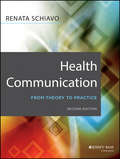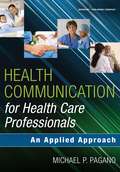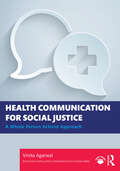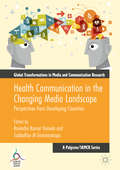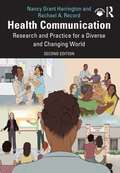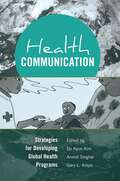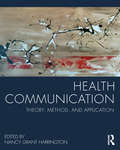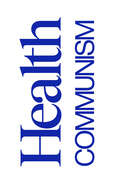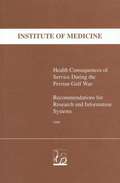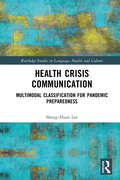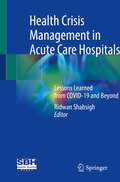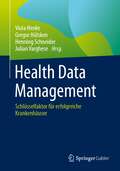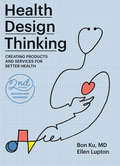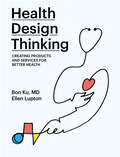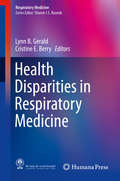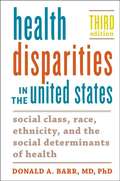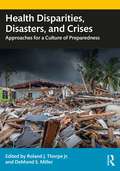- Table View
- List View
Health Communication
by Renata SchiavoHealth Communication: From Theory to Practice is a much needed resource for the fast-growing field of health communication. It combines a comprehensive introduction to current issues, theories, and special topics in health communication with a hands-on guide to program development and implementation. While the book is designed for students, professionals and organizations with no significant field experience, it also includes advanced topics for health communication practitioners, public health experts, researchers, and health care providers with an interest in this field.
Health Communication and Disease in Africa: Beliefs, Traditions and Stigma
by Bankole Falade Mercy MurireThis book is a collection of essays from across Africa which highlight the roles of beliefs and traditions in health behaviour. Chapters address mental health, risk perception, stigma, reproductive health, religion and health. The book also examines conceptual approaches in health communication and community development, both western and indigenous. Specific topics include Alzheimer’s, HIV and stigma; perception of risk from obesity, HIV prevention and preeclampsia; doctor-patient relationship and health beliefs of birth attendants; culture and mental health access and social media effects on mental health; the complementary use of contemporary and indigenous communication strategies and the accommodation of science by religious leaders during the COVID 19 pandemic. The book, which starts by examining global inequalities in health, proposes an African approach informed by problematisation as theorised by Foucault and Freire, to unpack habits and social problems. It ends by asking the question: “Is science enough” and making a strong case for health enabling environments alongside science communication.
Health Communication for Health Care Professionals: An Applied Approach
by Michael P. PaganoThe author underscores the importance of developing and maintaining successful relationships with patients, peers, and colleagues as a cornerstone of effective health care outcomes. With an emphasis on interactive learning, the text utilizes communication theories to analyze verbal and non-verbal behaviors in diverse health care contexts and assess which are more effective and why.
Health Communication for Social Justice: A Whole Person Activist Approach (Routledge Social Justice Communication Activism Series)
by Vinita AgarwalThis textbook combines whole person and social justice perspectives to educate students on the role of communication in promoting inclusive and person-centered healthcare practices. This book explores health inequities experienced by disadvantaged and marginalized populations and outlines the actions students can take to address these challenges. The book demonstrates how physical, mental, and emotional health is connected to equitable understandings of individual, community, and environmental health. It considers how social, interpersonal, and systemic factors such as personal relationships, language, literacy, religion, technology, and the environment affect health equity. To present strategies and invite action to support the goals of the whole person, social justice activist approach, the book provides contemporary examples, interviews with communication scholars, and case studies that examine local communities and the everyday contexts of health meaning making. This textbook serves as a core or supplemental text for graduate and upper-level undergraduate courses in health communication. Online resources include PowerPoint slides and an instructor manual containing sample syllabi, assignments, and test questions. They are available online at www.routledge.com/9781032081038.
Health Communication in the Changing Media Landscape
by Ravindra Kumar Vemula Subbarao M GavaravarapuThis book advances new understandings of how technologies have been harnessed to improve the health of populations; whether the technologies really empower those who use information by providing them with a choice of information; how they shape health policy discourses; how the health information relates to traditional belief systems and local philosophies; the implications for health communicators; how certain forms of silence are produced when media articulates and problematizes only a few health issues and sidelines others; and much more. The book brings together current research and discussions on the three areas of policy, practices and theoretical perspectives related to health communication approaches in developing countries, presenting well-researched and documented essays that will prove helpful for academic and scholarly inquiry in this area.
Health Communication: From Theory to Practice
by Renata Schiavo"Health Communication: From Theory to Practice" is a much needed resource for the fast-growing field of health communication. It combines a comprehensive introduction to current issues, theories, and special topics in health communication with a hands-on guide to program development and implementation. While the book is designed for students, professionals and organizations with no significant field experience, it also includes advanced topics for health communication practitioners, public health experts, researchers, and health care providers with an interest in this field.
Health Communication: Research and Practice for a Diverse and Changing World
by Nancy Grant Harrington Rachael A. RecordThis thoroughly revised second edition covers the major areas of research, theory, and practical application in health communication. This textbook takes an in-depth approach to health communication by analyzing and critically evaluating research conducted across multiple paradigmatic perspectives and focusing on translational application of research findings. Using the story of the Montgomery family, a biracial, multigenerational family, and their health experiences as a case study, chapters explore topics including patient–provider communication, health communication in the media, ethical issues, and public health crises. New chapters cover the potential for communication to address discrimination in healthcare settings, health information seeking, social support and caregiving, and the relationship between health and environmental communication. Chapters offer pedagogical features that will prove useful to students and instructors of health communication, such as summary boxes, theory tables, suggestions for in-class activities, discussion questions, and lists of additional resources. Developed for use in advanced undergraduate and master’s level health communication and public health courses, this text represents the breadth and depth of health communication theory and research as it exists today. Online resources for instructors including additional theory tables, PowerPoint slides, test questions and assignments, sample syllabi, and lists of additional resources are available at https://www.routledge.com/9781032100470.
Health Communication: Strategies for Developing Global Health Programs (Health Communication #5)
by Arvind Singhal Gary L. Kreps Do Kyun KimPromotion of healthy behaviors and prevention of disease are inextricably linked to cultural understandings of health and well-being. Health communication scholarship and practice can substantially and strategically contribute to people living safer, healthier, and happier lives. <p><p>This book represents a concrete step in that direction by establishing a strategic framework for guiding global and local health practices.
Health Communication: Theoretical and Critical Perspectives
by Ruth Cross Ivy O'Neil Sam DavisHealth communication is key to promoting good population and individual health outcomes. As the field has developed, there is a growing need for a critical appraisal of the ideologies and theories underpinning health communication in order to ensure effective practice. This book clearly situates health communication within its social context. It provides a critical overview of three key disciplinary areas - education, psychology and communication. Drawing on international examples throughout, the book challenges the underlying assumptions that drive the design and delivery of health promotion interventions. The authors argue that health communication is inherently political and pay close attention to issues of power, ethics and inequality throughout the text. This book will be valuable for those students at all levels who require a critical perspective, as well as practitioners in health communication and health promotion. With reference to detailed examples and annotated suggestions for further reading, the book is an accessible resource for analysing contemporary health communication.
Health Communication: Theory, Method, and Application
by Nancy Grant HarringtonHealth Communication provides coverage of the major areas of interest in the field of health communication, including interpersonal, organizational, and health media. It takes an in-depth approach to health communication research by analyzing and critically evaluating research conducted across multiple paradigmatic perspectives. This edited textbook includes chapters covering such topics as: interpersonal health communication issues, challenges, and complexities in health communication, communication aspects of health behaviors and conditions, organizational issues in health communication, and media and eHealth research. Chapters have been contributed by noted researchers and educators in health communication and represent the current state of the field. They offer pedagogical features that will prove useful to students and instructors of health communication, such as sidebars, summary boxes, suggestions for in-class activities, discussion questions, and lists of additional resources. A companion website provides online resources for use with this text, including: For students: Test questions Downloadable flash cards Exam study guides For instructors: PowerPoint slides Sample syllabi Sample assignments Developed for use in upper-level health communication courses, this text represents the breadth and depth of health communication theory and research as it exists today.
Health Communism: A Surplus Manifesto
by Beatrice Adler-Bolton Artie VierkantA searing analysis of health and illness under capitalism from hosts of the hit podcast &“Death Panel&” In this fiery, theoretical tour-de-force, Beatrice Adler-Bolton and Artie Vierkant offer an overview of life and death under capitalism and argue for a new global left politics aimed at severing the ties between capital and one of its primary tools: health. Written by co-hosts of the hit &“Death Panel&” podcast and longtime disability justice and healthcare activists Adler-Bolton and Vierkant, Health Communism first examines how capital has instrumentalized health, disability, madness, and illness to create a class seen as &“surplus,&” regarded as a fiscal and social burden. Demarcating the healthy from the surplus, the worker from the &“unfit&” to work, the authors argue, serves not only to undermine solidarity but to mark whole populations for extraction by the industries that have emerged to manage and contain this &“surplus&” population. Health Communism then looks to the grave threat capital poses to global public health, and at the rare movements around the world that have successfully challenged the extractive economy of health. Ultimately, Adler-Bolton and Vierkant argue, we will not succeed in defeating capitalism until we sever health from capital. To do this will require a radical new politics of solidarity that centers the surplus, built on an understanding that we must not base the value of human life on one&’s willingness or ability to be productive within the current political economy. Capital, it turns out, only fears health.
Health Consequences of Service During the Persian Gulf War: Recommendations for Research and Information Systems
by Committee to Review the Health Consequences of Service During the Persian Gulf WarIn January 1995 the Institute of Medicine released a preliminary report containing initial findings and recommendations on the federal government's response to reports by some veterans and their families that they were suffering from illnesses related to military service in the Persian Gulf War.The committee was asked to review the government's means of collecting and maintaining information for assessing the health consequences of military service and to recommend improvements and epidemiological studies if warranted. This new volume reflects an additional year of study by the committee and the full results of its three-year effort.
Health Crises and Media Discourses in Sub-Saharan Africa
by Carol Azungi Dralega Angella NapakolThis is an open access book which brings together leading scholars and critical discourses on political, economic, legal, technological, socio-cultural and systemic changes and continuities intersecting media and health crises in Sub-Saharan Africa. The volume extensively discusses COVID-19 but it also covers other epidemics, such as malaria, HIV/AIDS as well as “silent” health crises such as mental health---simmering across the subcontinent. The chapters fill knowledge gaps, highlight innovations, unpack the complexities surrounding the media ecosystem in times of health crises. They explore, among other issues, the politics of public health communication; infodemics; existential threats to media viability; draconian legislations; threats to journalists/journalism; COVID-related entrepreneurship, marginalization, and more.This is a timely resource for academics, advocacy groups, media practitioners and policy makers working on crises and media reporting, not just in Africa but anywhere in the global South.
Health Crisis Communication: Multimodal Classification for Pandemic Preparedness (Routledge Studies in Language, Health and Culture)
by Sheng-Hsun LeeSheng-Hsun Lee develops a new way of understanding public health crisis communication through the lens of multimodal classification. He draws on examples from COVID-19 press conferences in Taiwan and public online comments to outline multimodal classification as sorting pandemic phenomena into categorical types.Lee argues that when public health officials classify health crisis phenomena into categories, they also set parameters for official responses and shape public perceptions of a crisis. He illustrates the argument through examining Taiwan’s initial successes in keeping most infections at bay and subsequent challenges of obtaining enough vaccines for international border reopening. The successes and challenges are closely linked to multimodal classification, which includes using speech, gestures, and objects to make some categories travel broadly and impede the circulation of other categories. The book discusses a wide range of crisis categories from the three dreadful first times—the first confirmed case, the first community-acquired case, and the first death—to the politicized debate over vaccine brands. Lee emphasizes the importance of understanding how crisis categories are produced, circulated, and received. The comprehensive coverage looks beyond initial responses to the COVID-19 pandemic and outside English-dominant places to redefine effective public health messaging. Based on the findings, the book highlights implications for communicating official messages and offers a list of ready-to-use strategies for updating existing guidelines on public health communication.The book is an essential read for public health practitioners and researchers and advanced students in discourse analysis and public health communication.
Health Crisis Management in Acute Care Hospitals: Lessons Learned from COVID-19 and Beyond
by Ridwan ShabsighIn the USA, the COVID-19 crisis came as an unpleasant surprise and a shock to many healthcare systems and hospitals, especially in the crisis epicenter, New York City. The Bronx was one of the hardest hit boroughs of New York City, with significant negative impact of the COVID-19 pandemic on its indigent population. SBH Health System (formerly known as St. Barnabas Hospital) is an integrated system of an acute care hospital, ambulatory care center, trauma center, dialysis center, stroke center and other services and facilities, serving the community of the Bronx. The story of SBH in preparing for and managing the rapidly escalating surge of severely ill patients is a treasure of lessons in health crisis preparedness and management at all levels: clinical, administrative, financial, etc. These lessons can be used for other acute care hospital settings and other potential health crises that may arise in the future. Within a short 3 weeks, SBH increased its in-patient capacity by 50%. However, during the same short time, it increased its critical care capacity by over 500%, providing critical care to severely ill patients on ventilators. This book chronicles the situation step by step and describes how this accomplishment was done. Accounts from the frontline health workers and from the clinical and administrative leaders describe important aspects of crisis management, such as team building, multi-departmental coordination, effective communications, dynamic decision-making in response to rapidly changing situations, keeping up the morale and caring for the healthcare workers and managing the supply chain. The uniqueness of the experience of SBH is enhanced by the fact that SBH is a low budget “safety net” hospital serving the poorest population in New York City. The worldwide trend is toward tighter healthcare budgets with demands for higher efficiency and productivity. There is a lot to be learned from the SBH health crisis management, including how efficient management, team building, management of limited resources and collaborative workplace culture make the foundation of success in the face of the crisis of the century. This unique text serves as a “how to” guide for implementing skills necessary for crisis management. Lessons from the success of SBH in tackling the dramatically fast unfolding crisis are utilized in a clear and concise manner. Such lessons may benefit other health systems and hospitals in planning and preparing for similar crises.
Health Data Management: Schlüsselfaktor für erfolgreiche Krankenhäuser
by Henning Schneider Viola Henke Gregor Hülsken Julian VargheseNeben der Einführung und Umsetzung einer Digitalstrategie spielt die ganzheitliche Verwaltung und Organisation von Gesundheitsdaten eine essenzielle Rolle für den Erfolg bei der digitalen Transformation in Krankenhäusern – kurz: ein professionelles Health Data Management (HDM).Dieses Buch widmet sich dieser Herausforderung, indem es in zahlreichen Expertenbeiträgen die dafür notwendigen Handlungsfelder aufzeigt – sie reichen von der Informationsstruktur und -architektur über die Datenerfassung und den interoperablen Datenaustausch bis hin zur Datenanalyse mit Künstlicher Intelligenz, Datenschutz und IT-Sicherheit. Anhand von Praxisbeispielen werden Bedeutung, Chancen, Herausforderungen und Lösungsansätze des Health Data Managements erläutert und konkrete Umsetzungsempfehlungen für den Wissenstransfer in den Klinikalltag gegeben.Die technischen Faktoren sollten bei der Planung und Umsetzung des HDM idealerweise durch „weiche“ Faktoren ergänzt werden, wie Unternehmenskultur, Führungsqualität und Mitarbeitermotivation, damit die Interaktion zwischen Mensch, Technologie, Prozessen und Kultur bei der digitalen Transformation im Krankenhaus gelingen kann. Nur so können Arbeitsabläufe verbessert, die Patientenversorgung optimiert, Prozesse vereinfacht, Diagnosen zielgenauer, Pflegekräfte und Ärzte entlastet und das Krankenhaus als Ganzes effizienter und wirtschaftlicher werden. Ein Blick in die Gesundheitssysteme anderer Länder und ihre Datenstrategien rundet dieses Buch ab.Health Data Management ist nicht nur ein technisches, sondern vielmehr ein gesellschaftliches Projekt mit dem Potenzial, das Gesundheitswesen grundlegend zu verändern und die Versorgung der Patienten auf ein neues und nachhaltiges Level zu heben.
Health Design Thinking, second edition: Creating Products and Services for Better Health
by Ellen Lupton Bon KuA practice-based guide to applying the principles of human-centered design to real-world health challenges; updated and expanded with post–COVID-19 innovations. This book offers a practice-based guide to applying the principles of human-centered design to real-world health challenges that range from drug packaging to breast cancer detection. Written by pioneers in the field—Bon Ku, a physician leader in innovative health design, and Ellen Lupton, an award-winning graphic designer—the book outlines the fundamentals of design thinking and highlights important products, prototypes, and research in health design. This revised and expanded edition describes innovations developed in response to the COVID-19 crisis, including an intensive care unit in a shipping container, a rolling cart with intubation equipment, and a mask brace that gives a surgical mask a tighter seal. The book explores the special overlap of health care and the creative process, describing the development of such products and services as a credit card–sized device that allows patients to generate their own electrocardiograms; a mask designed to be worn with a hijab; improved emergency room signage; and a map of racial disparities and COVID-19. It will be an essential volume for health care providers, educators, patients, and designers who seek to create better experiences and improved health outcomes for individuals and communities.
Health Design Thinking: Creating Products and Services for Better Health
by Ellen Lupton Bon KuApplying the principles of human-centered design to real-world health care challenges, from drug packaging to early detection of breast cancer.This book makes a case for applying the principles of design thinking to real-world health care challenges. As health care systems around the globe struggle to expand access, improve outcomes, and control costs, Health Design Thinking offers a human-centered approach for designing health care products and services, with examples and case studies that range from drug packaging and exam rooms to internet-connected devices for early detection of breast cancer. Written by leaders in the field—Bon Ku, a physician and founder of the innovative Health Design Lab at Sidney Kimmel Medical College, and Ellen Lupton, an award-winning graphic designer and curator at Cooper Hewitt Smithsonian Design Museum—the book outlines the fundamentals of design thinking and highlights important products, prototypes, and research in health design.Health design thinking uses play and experimentation rather than a rigid methodology. It draws on interviews, observations, diagrams, storytelling, physical models, and role playing; design teams focus not on technology but on problems faced by patients and clinicians. The book's diverse case studies show health design thinking in action. These include the development of PillPack, which frames prescription drug delivery in terms of user experience design; a credit card–size device that allows patients to generate their own electrocardiograms; and improved emergency room signage. Drawings, photographs, storyboards, and other visualizations accompany the case studies.Copublished with Cooper Hewitt, Smithsonian Design Museum
Health Diplomacy in Africa: Trends, Challenges, and Perspectives (Studies in Diplomacy and International Relations)
by Humphrey Ngala Ndi Henry Ngenyam Bang Zebulon Suifon Takwa Anna Tasha MburThe purpose of this book is to project diplomacy as an unavoidable instrument for monitoring, prevention and control of health and disaster risks among African countries. The book advocates health cooperation in Africa at a time when pandemics are recurrent. Outside of the WHO, many countries, even within regional groupings have not actively pursued health cooperation. We intend this book to provide the basis for advocating the inclusion of health diplomacy in the curricula of the training of the African diplomat with the hope to stimulate gradual policy shifts in foreign ministries, regional groupings, and the African Union.
Health Disparities in Allergic Diseases: An Evidence-Based Look at Causes, Conditions, and Outcomes
by Mahboobeh MahdaviniaThis book comprehensively and thoroughly reviews the current literature regarding the impact of health disparities and socioeconomic factors on allergic diseases outcomes: such as food allergies and anaphylaxis. The morbidity associated with these conditions is significantly higher in under-privileged populations around the world, including groups who have experienced greater social or economic obstacles to health based on racial, socioeconomic, gender, geographic location. Health Disparities in Allergic Diseases presents evidence and reviews studies from both developed and developing countries that witness health disparities in allergic disease.Concise in format, Health Disparities in Allergic Diseases: An Evidence-Based Look at Causes, Conditions, and Outcomes is made up of 11 expertly written chapters and divided into two parts. It begins with an introductory on global health through an analysis of the theoretical framework of epidemiologic transition. Subsequent chapters then review the socioeconomic and racial variables in treating allergic diseases using a multifactorial approach. Part II discusses disparities in allergic conditions, including asthma health, rhinitis and rhinosinusitis, food allergy, and atopic dermatitis. The book concludes with an exploration of potential strategies to providing solutions for asthmatic impoverished populations.Health Disparities in Allergic Diseases is a practical resource that can be used by researchers and clinicians in the field of allergy who are interested in learning about health related disparities in the context of allergic conditions or who seek solutions for this important issue.
Health Disparities in Respiratory Medicine
by Lynn B. Gerald Cristine E. BerryThis book discusses health disparities in respiratory medicine and suggests methods to reduce them. In the United States, health disparities are well documented in the care of patients with respiratory disorders, particularly among minorities who often have higher rates of disease and poorer health outcomes. Similarly, differences in health and health outcomes exist between differing socioeconomic groups, with lower income groups generally having poorer health and higher rates of chronic illness. Health Disparities in Respiratory Medicine investigates these differing outcomes through the complex connections between access and quality of treatment available to these groups. Chapters are organized around either causes, diseases, or types of care, including tobacco smoke exposure, environmental air quality, acute respiratory distress syndrome, chronic obstructive pulmonary disease, and end-of-life care. This volume is an ideal resource for pulmonologists, health care administrators, and policy makers who aim to understand disparities in respiratory medicine and take steps to improve the differences among groups.
Health Disparities in Youth and Families
by Lisa J. Crockett Gustavo Carlo Miguel A. CarranzaAmid its growing diversity and shifting demographics, the U.S. is still home to glaring health inequities by race, ethnicity, and class. Yet while it is customary to identify poverty as their root cause, other complex mechanisms are involved in their perpetuation. Based on recent major studies on African-American, Latino, Asian-American, and Native American populations, Health Disparities in Youth and Families offers a thorough, nuanced examination of a wide range of causal--and protective--factors. Rigorous theories and models take into account cultural, contextual, and personal variables, including the roles of family identity, school, and neighborhood, and motivation toward health awareness (with attention paid to less frequently studied phenomena such as within-group inequalities and the Hispanic Health Paradox). Contributors approach their subjects with realism as well as optimism as the book: povides reliable information on the scope and etiology of health disparities, identifies the methodological and political challenges associated with this issue, proposes comprehensive, integrative models for understanding disparities, features examples of innovative programs for improving minority health, includes an in-depth chapter on substance use and mental health among Native American youth, offers a useful starting point for the exchange of ideas necessary to address health disparities. A provocative resource on a pressing social concern, Health Disparities in Youth and Families is necessary reading for health policy researchers, health care providers, and others dedicated to better health outcomes for all Americans.
Health Disparities in the United States: Social Class, Race, Ethnicity, and the Social Determinants of Health
by Donald A. BarrAn essential text for courses in public health, health policy, and sociology, this compelling book is a vital teaching tool and a comprehensive reference for social science and medical professionals.
Health Disparities in the United States: Social Class, Race, Ethnicity, and the Social Determinants of Health
by Donald A. BarrChallenging students to think critically about the complex web of social forces that leads to health disparities in the United States.The health care system in the United States has been called the best in the world. Yet wide disparities persist between social groups, and many Americans suffer from poorer health than people in other developed countries. In this revised edition of Health Disparities in the United States, Donald A. Barr provides extensive new data about the ways low socioeconomic status, race, and ethnicity interact to create and perpetuate these health disparities. Examining the significance of this gulf for the medical community and society at large, Barr offers potential policy- and physician-based solutions for reducing health inequity in the long term.This thoroughly updated edition focuses on a new challenge the United States last experienced more than half a century ago: successive years of declining life expectancy. Barr addresses the causes of this decline, including what are commonly referred to as "deaths of despair"—from opiate overdose or suicide. Exploring the growing role geography plays in health disparities, Barr asks why people living in rural areas suffer the greatest increases in these deaths. He also analyzes recent changes under the Affordable Care Act and considers the literature on how race and ethnicity affect the way health care providers evaluate and treat patients.As both a physician and a sociologist, Barr is uniquely positioned to offer rigorous medical explanations alongside sociological analysis. An essential text for courses in public health, health policy, and sociology, this compelling book is a vital teaching tool and a comprehensive reference for social science and medical professionals.
Health Disparities, Disasters, and Crises: Approaches for a Culture of Preparedness
by Roland J. Thorpe Jr. DeMond S. MillerHealth Disparities, Disasters, and Crises: Approaches for a Culture of Preparedness presents a roadmap to help guide the actions needed to address health disparities introduced as part of the pre-planning, planning, and mitigation phases of natural and technological disasters. With contributions from 30 scholars in disaster management in public health, this text explores how the intersectionality of health disparities of different socioeconomic and racial/ethnic groups and how social determinants help shape exposure, and vulnerability to pandemic disasters and crises. Supported by examples from across the world, chapters are supplemented with case studies of best practices, graphs, and tables. Each of the seven parts address different topics, including how disasters affect the poor, medically underserved, and racial/ethnic groups, the impact of health disparities, and the growing link between global health, disaster planning/mitigation, and global security. Written for the benefit of undergraduate and graduate students, working professionals, and academics in the US and abroad, Health Disparities, Disasters, and Crises: Approaches for a Culture of Preparedness provides the best overall understanding of professional disaster management and safety for all citizens. It is also an ideal text for graduate and undergraduate courses in public health, public policy, medicine and nursing, healthcare administration, emergency management, emergency preparedness, homeland security, epidemiology, sociology, and medical sociology.
